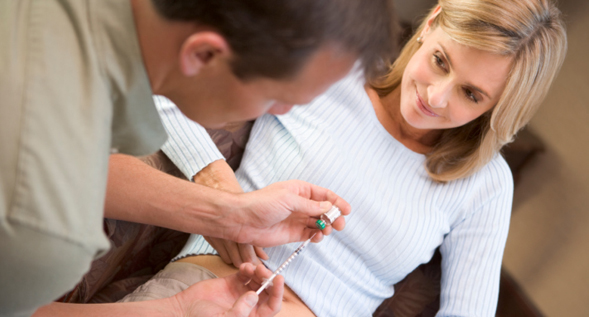Fertility Drugs | Generally the first line of treatment for fertility issues, these drugs can either be injected or taken in pill form, and they release hormones that induce ovulation. The goal? To boost egg production and get the uterus ready for embryo implantation. The good news is that the success rate for women taking these drugs is high: 40 to 45 percent of women who take the pills and successfully ovulate get pregnant, and 50 percent of women who ovulate as a result of the shots get pregnant. Drawbacks include symptoms such as bloating, headaches, nausea, and in worst-case scenarios, an increased risk of multiple births, premature delivery, and ovarian cysts. While the cost of these drugs varies, they range from $60 to $1,000 per cycle.
Artificial Insemination (IUI) | In most cases, this procedure happens after a round or two of fertility drugs doesn’t lead to pregnancy. With IUI, sperm are inserted directly into the uterus via a catheter. While the procedure’s success rate sounds meager—15 to 20 percent chance of conception per cycle—it has a 60 to 70 percent chance of working after six cycles. The upside is that this is a relatively simple procedure that happens in your doctor’s office; downsides include side effects from the fertility medication as well as a greater chance of multiple births.The average cost of IUI is $300 to $700 per cycle, plus the cost of fertility drugs and ultrasound monitoring (making it anywhere from $1,000 to $4,000, experts say).
In Vitro Fertilization (IVF) | Considered the big gun of the fertility treatment arsenal, IVF is a multi-step process: After a rigorous round of fertility drugs to boost ovulation, the woman’s eggs are retrieved, extracted, and fertilized with sperm in a petri dish; the embryos then grow in the lab over the course of 1 to 5 days, and the strongest and healthiest one or two are implanted in the woman’s uterus. Success rates vary largely by age, with live births resulting in 30 to 35 percent of women under age 35, 25 percent of women ages 35 to 37, 15 to 20 percent of woman ages 38 to 40, and 6 to 10 percent of women over 40. At an average of $12,400 per cycle, IVF isn’t cheap—but it’s considered the best option for older women.
Donor Sperm and/or Eggs | Donor sperm can be used for couples experiencing male-factor fertility issues, such as low sperm count, slow-moving sperm, and men carrying genetic mutations. If this is the case, sperm from a male donor are used during IUI or IVF. The expense is around $300, and the pregnancy success rate is about 15 percent after one cycle and 80 percent after six cycles. Donor eggs are most commonly used when egg quality is poor in older women. While some women may not want to have a baby that doesn’t have their own genetic makeup, the success rates using donor eggs are high: About 55 percent of women using fresh donor eggs will give birth, and 34 percent will give birth when frozen eggs are used. This procedure is significantly more expensive than donor sperm, with the cost anywhere from $15,000 to $30,000 including IVF and compensation for the donor.









